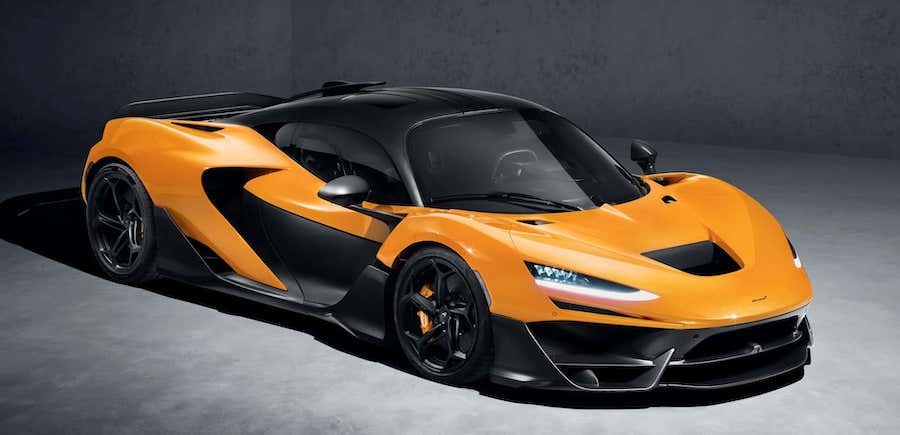In 1992, the McLaren F1 laid the framework for all hypercars. Then in 2012, McLaren revolutionized the industry with its first hybrid hypercar, the P1. Now, more than 30 years after the original F1, McLaren is reinventing the segment yet again with its most powerful road car to date.
The McLaren W1 is powered by a new twin-turbocharged 4.0-liter V-8 with battery assist. It has 1,258 horsepower and 988 pound-feet of torque, which gives it a 0-60 mph time of 2.7 seconds and an electronically limited top speed of 217 mph—same as the P1.
But the numbers only tell part of the story, as impressive as they are.
The new engine—dubbed the "MPH-8"—was built entirely from the ground up. It makes 916 horsepower and has the highest output of any McLaren engine ever produced: 230 bhp-per-liter. Its lightweight block, rigid valvetrain, and plasma spray-coated cylinder bores help get it to a 9,200-rpm redline, while the two twin-scroll turbochargers come alive at just 2,500 rpm.
The new V-8 is joined by an "E-Module," which consists of a radial flux electric motor, a motor control unit, and a 1.4-kilowatt-hour battery pack. It adds an additional 342 hp to the gas engine's output and allows the McLaren W1 to drive on electricity alone for a scant 1.6 miles. Better than nothing.
Astonishingly, McLaren's new E-Module only weighs 44 pounds. The total weight of all the hybrid components has been reduced by 88.2 pounds compared to the P1. The McLaren W1 has a dry weight of just 3,084 pounds. That's only 9 pounds heavier than the P1 (3,075 pounds dry).
Horsepower and torque are sent exclusively to the rear wheels courtesy of an electronic differential, and it's all paired to an eight-speed automatic transmission with an electronic reverse gear.
The design is centered around McLaren's new "Aerocell" monocoque chassis, which combines a fixed seating position with steering wheel and pedal adjustments, and new "Anhedral Doors." The Aeorcell's integrated seating helped McLaren save 2.8 inches in wheelbase, while the Anhedral doors improve airflow over the front fenders.
The McLaren W1 has a dry weight of just 3,084 pounds. That's only 9 pounds heavier than the P1.
McLaren spent more than 350 hours in the wind tunnel with the W1 and tested more than 5,000 individual points to ensure it was the most aerodynamic supercar the company has ever built.
The W1 has an "Active Long Tail" rear wing inspired by the 1997 F1 GTR that improves drag and increases downforce. McLaren says this car has "shape-shifting abilities"—and we believe it. An airflow diverter on the roof (the first in a street-legal McLaren) sends fresh air to the engine bay while active front and rear wings help generate 772 and 1,433 pounds of downforce respectively in Race mode. The W1 has a total downforce figure of 2,205 pounds.
The ride height drops by 1.5 inches at the front and 0.7 inches at the rear in Race mode, while the long tail spoiler extends up to 11.8 inches when activated. It also acts as an air brake under heavy braking. Here's what it looks like in action:
Under the slippery body is McLaren's new Race Active Chassis Control III, which is configurable in three different settings: Comfort, Sport, and Race. Forged six-piston calipers up front and four-piston calipers in the rear with carbon ceramic discs help bring the W1 down to speed quickly. From 62 mph, the McLaren W1 stops in 95 feet. From 124 mph, it takes just 328 feet.
To help keep all that power connected to the road, the W1 comes standard with Pirelli P Zero Trofeo RS tires measuring 265/35 up front and 335/30 in the rear. McLaren also offers P Zero R tires for more regular road use and Pirelli P Zero Winter 2 tires.
The cockpit has an 8.0-inch touchscreen with Apple CarPlay and Android Auto compatibility, as well as USB-A and USB-C connections. And a small shelf behind the seats offers up to 4.1 cubic feet of in-car storage.
The price for all this unbelievable performance? A cool $2.1 million. McLaren will only build 399 examples of the W1, and as you’d expect, all of them are already accounted for.

Related News



